New perk! Get after it with local recommendations just for you. Discover nearby events, routes out your door, and hidden gems when you sign up for the Local Running Drop.
Running Injury: An emotionally (and physically) painful time in every runner’s life where they acquire the hindsight necessary for preventing future running related injuries. i.e., the importance of prehab.
Regret is a word I would use to describe the time I spent running before I found my physical therapist, and not just because he listens to me complain about being sore or because he gives me great relationship advice. I regret that period of time because my PT taught me that if I want to stay injury free, I have to do the work.
Most runners don’t seek out physical therapy until they’re injured but the truth is, there’s a lot we can do to keep runner’s knee, ITBS, shin splints, as well all the other evil running injuries that wreak havoc on both our sanity and training schedules.
I asked my wizard of a physical therapist—Mike Riccardi at Finish Line Physical Therapy (and when I say wizard, I mean wizard; I sprained my ankle a week before the Berlin Marathon and he had me running pain free within 7 days. #Magic) what every physical therapist wished runners would add to their training schedules to prehab running injuries.
So grab a pen and paper, because he’s about to give you the secret to an injury free year! Ready, here we go!
1. Foam Roll: Calves and Quads
Okay, so this is a no brainer, but raise your hand if you’re actually foam rolling like you’re supposed to…that’s what I thought. (It’s okay, I’m not either. This is a safe space. We can be honest.) According to Mike, “Foam rolling is one of the best ways to keep muscles healthy and hydrated. The most important thing to remember while foam rolling is to move slowly up and down the muscle, remembering to turn the body slightly to get the outer and inner parts of the quads and calves.”
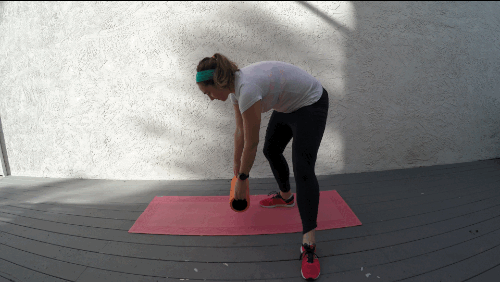
PRO TIP: Try foam rolling before you run in addition to after. “It will help warm up the tissues by improving circulation, which will hopefully help prevent pain.”
How often should you foam roll? Daily.
2. Trigger Point: TFL
If there’s a discomfort runner’s know well, it’s a tight IT band. But it turns out, our IT band isn’t a muscle and really can’t get ‘tight.’ “However, it does attach to a small muscle towards the front outer hip called the tensor fascia latae (TFL), which can get overworked and tight in a lot of runners causing it to pull on the IT band and create a sensation of tightness. It can be released with foam rolling to a degree but since it is a small muscle, I find that digging in with a lacrosse ball is more effective.“
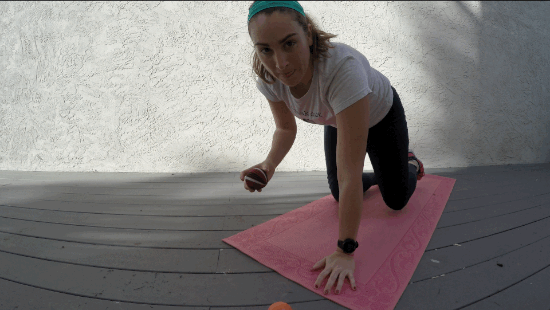
AMATEUR TIP: The use of expletives make the experience a lot less painful.
How often should you dig away? Daily.
3. Hip Flexor Stretch
If you spend a majority of your day sitting, the hip flexor stretch is for you. “The most obvious way that tight hips affect running is that runners can’t let their legs extend behind them in their stride. Normally the hip flexor would act as a rubber band, getting stretched out and then recoiling as you pick you foot up. Since most people are too tight to allow it to get properly stretched out, they then overwork the muscles when driving their foot forward.”
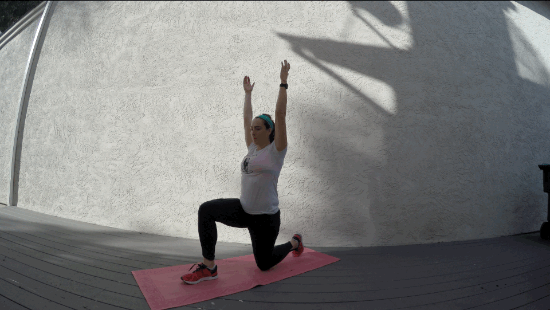
PRO TIP: Add this stretch to your warm up.
How often should you do it? DAILY.
4. Squats
Tight quads, weak glutes and weak hamstrings. Sound familiar? It should, because it’s the norm for most runners. “This muscle strength and length imbalance is one of the biggest reasons for pathology in runners along with poor running form and mechanics. Squats are a great way to build a strong foundation for running. Varying the foot position is a good way to ensure you’re hitting all aspects of the muscles.”
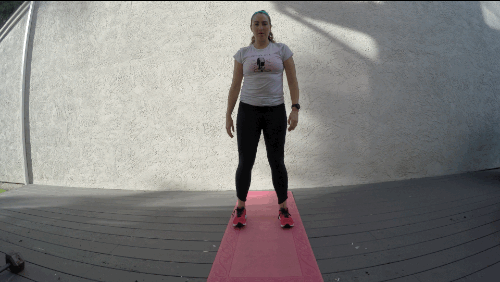
PRO TIP: “If you feel like your form isn’t great, try changing it to a ‘Goblet Squat’ by holding a light dumbbell vertically against your chest with both hands. It may sound counterintuitive to add weight if your form isn’t perfect yet, but the small weight can help shift your center of mass and make getting into the squat position easier. Then, once your form improves, try to up the weight.“
How often should you do it? Three days a week. Try starting with just a set or two and then building up to 3-4 sets of 10-20 repetitions.
5. Walking Lunges
Why walking lunges? Because they mimic running!
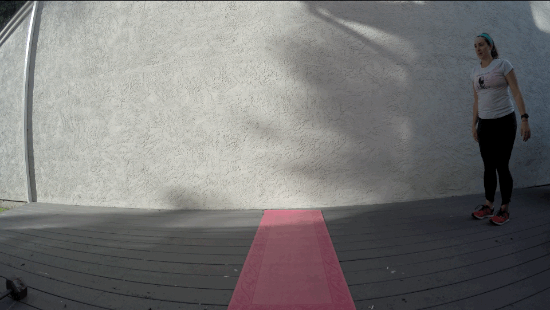
PRO TIP: “Take a big step forward, try to keep the weight even throughout the foot but to prevent the knee from moving forward too much. Shift as much weight as possible onto the front leg (while preventing the knee from moving forward over the toes) and then reach forward and down right in front of the lunging legs knee. Reaching forward and down helps counterbalance your hips and makes it easier to keep the knee back. You should primarily feel this in the hamstring and glutes.”
How often should you do it? Three days a week. Work up to 3 sets of 10 lunges on each leg. As it gets easier, try adding weight by holding a medicine ball or a dumbbell.
6. Side Lunges
Why side lunges? Because “runners often lack mobility in the frontal (side to side) and transverse (rotational) planes. Side lunges get you to move into the frontal plane and open up the hips, stretching the adductors slightly while also strengthening the glutes.”
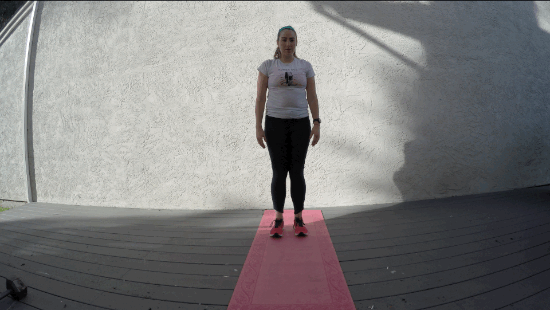
PRO TIP: “Just like the walking lunge, reach forward and down in front of the knee so that you can sit back into your hip. Try to keep the foot, knee and hip of the stepping leg all in one vertical line by not stepping too far.”
How often should you do it? Three days a week. Work up to 3 sets of 10 on each leg.
7. Rotational Lunges
“For similar reasons to the side lunges, rotational lunges are great because they open up the hips in ways that most exercises don’t. Most of these exercises I view as part strength and part mobility, but that is particularly true for this one.”
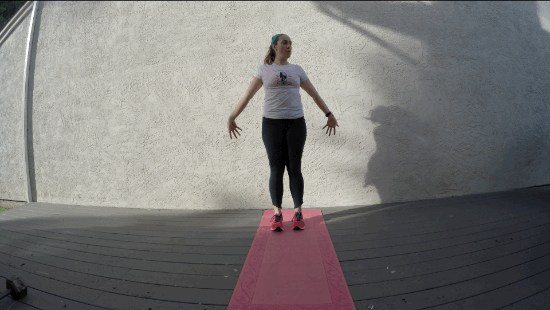
PRO TIP: “Pretend you are standing on a large clock on the number 12. Take your right foot and follow the arc of the clock, landing with your foot where 3 o’clock would be, pointing to the right. Reach in front of the stepping legs knee by hinging forward at the hips.”
How often should you do it? At least three days a week. Work up to 3 sets of 10 lunges on each leg.
8. Single Leg Deadlift
Oh deadlifts, Mike’s favorite way to torture me. Terrible balance + weak everything = this mess…
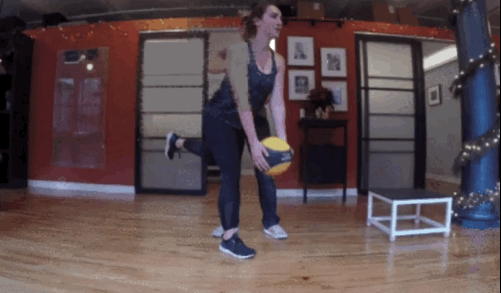
“Deadlifts work one leg at a time (just like running), and focus on the hamstring (one of the most important muscles in running, which is usually weak in most people), and even incorporates some balance at the same time. Kelly has terrible balance. It’s how I know she’s not doing her deadlifts when she’s not with me in PT.”
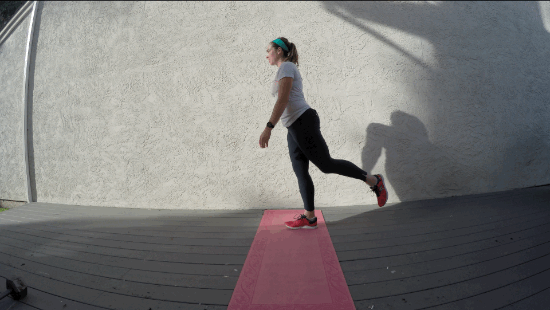
PRO TIP: “Stand on one leg with a slight bend in the knee. Then simply tilt forward by hinging from the hips, keeping the back relatively flat and letting the opposite leg extend up to act as a counterbalance. Be careful not to rotate up when doing this one, so focus on keeping the hip that is in the air down low when you are in the down position. Add weight to make it harder by holding a dumbbell in the hand on the side that is up in the air and letting the weight hang over the standing foot. So if you are standing on your right foot, the dumbbell or weight should be in your left hand.”
How often should you do this? Three days a week. Work up to 3 sets of 10.
9. Rear-Foot Elevated Split Squats
Another favorite of Mike’s because it kills the hamstrings and glutes. You’re going to need a box, bench, couch or elevated surface.
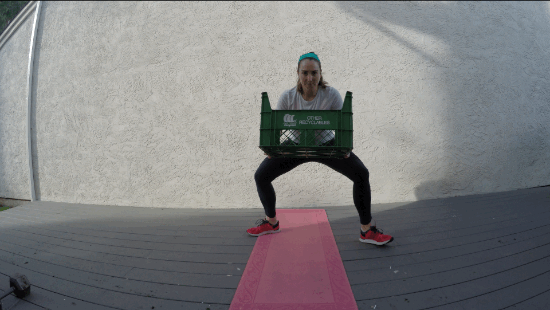
PRO TIP: “Stand in front of step facing away from it and place one foot behind you on top of the step. Stand far enough away so that as you sink down, the knee of the front foot doesn’t move forward much. Reach forward in front of knee and then drive through the front foot/heel as you stand up fully. If this exercise is too hard to get right at first, then start by doing a simple split squat. It’s a good prerequisite to being able to progress to the rear-foot elevated split squat (sometimes called the Bulgarian Split Squat). To do a regular split squat, just move your right foot forward about 2-3 feet. Drop the back knee towards the floor while keeping the chest relatively tall. You can tilt forward at the hips slightly to engage the glutes more. Keep the weight through the heel of the front foot, again, not letting the knee move forward much. Make it harder by adding a dumbbell in the goblet squat position before progressing to the rear-foot elevated split squat.”
How often should you do this: Three days a week. Work to 3 sets of 10.
In a perfect world, we’d all follow Mike’s advice, add these nine exercises into our routines, and stay injury free. But this isn’t a perfect world, and it’s because we fail to heed this advice that physical therapists like Mike stay in business. So, if you’re looking to stay injury free, pencil these exercises into your weekly training plan. But if you like getting hurt, you do you.
But remember, only you can prevent running injuries.
Until next time, #RunSelfieRepeat.